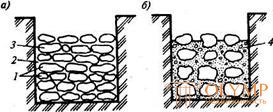
3. Laying "under the bay"
Laying "under the bay " - each row of stones 15 ... 20 cm high is laid dry into a ram with trench walls or formwork, the voids are filled with rubble and filled with 13 ... 15 cm moistening liquid solution. The solution does not fill all the holes, voids, which reduces its strength. Stones are laid without strict ligation of the seams and the device of the milestones; it is less time consuming and does not require highly skilled masons. Therefore, on such foundations and with such a system, masonry is allowed to erect buildings with a height of no more than two floors.

Fig.12.2. Masonry from natural stones of irregular shape:
a - rubble; b - concrete masonry; / - milestones; 2 - solution; 3 - bedded stones; 4 - concrete mix
4. Laying "under the shovel"


 Laying “under the scapula” is performed in horizontal rows of stones selected in height with bandaging the stitches along a single-ligation system. Begin laying with laying the outer and inner miles on the solution with a row height of up to 30 cm. In between the gaps, lay a solution with mobility of 4 ... 6 cm and put zabutka stones. The gaps between the stones are broken. The laying turns out rather strong, in the way "under a shovel" spread the bases, walls and columns.
Laying “under the scapula” is performed in horizontal rows of stones selected in height with bandaging the stitches along a single-ligation system. Begin laying with laying the outer and inner miles on the solution with a row height of up to 30 cm. In between the gaps, lay a solution with mobility of 4 ... 6 cm and put zabutka stones. The gaps between the stones are broken. The laying turns out rather strong, in the way "under a shovel" spread the bases, walls and columns.
To give the masonry more durability, it can be carried out with a brick lining on the outside by a multi-row system with dressing through 4 ... 6 rows.
The stone and mortar are always placed outside the trench, often the bricklayer is in the trench itself, and the handyman, being on the curb, delivers the necessary materials to the work area.
Concrete laying is distinguished by the fact that the stones are sunk into the laid concrete mix in horizontal rows with subsequent vibration (Fig. 8, b). Masonry lead in thrust with the walls of the trench or formwork. The concrete mixture is laid in layers of 20 cm, stones are sunk to half their height with gaps between them of 4 ... 6 cm. The maximum size of stones should not exceed 1/3 of the thickness of the erected structure. The masonry vibrates when the mobility of the concrete mix is 5 ... 7 cm or compacted with rammers when the mobility of the mixture is within 8 ... 12 cm. This masonry is durable, less labor-intensive than rubble, but it requires more wood for the formwork and a very significant consumption cement, as the volume of stone from the total "volume of masonry is slightly more than 50%.
Что бы оставить комментарий войдите
Комментарии (0)